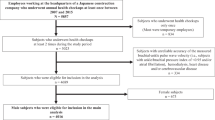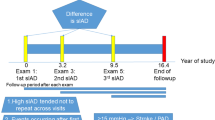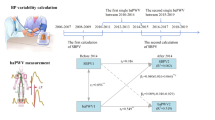Abstract
No longitudinal study addressed whether systolic blood pressure level (SBPL) or within-visit variability (SBPV) predict arterial properties or vice versa. In families randomly recruited from a Flemish population, we determined SBPL and SBPV from five consecutive blood pressure readings. The indexes of SBPV were variability independent of the mean, the difference between maximum and minimum SBPL, and average real variability. We measured carotid intima-media thickness and distensibility by ultrasound and carotid–femoral pulse wave velocity by tonometry (SphygmoCor, version 8.2). Effect sizes were computed for 1-s.d. increments in the predictors, while accounting for covariables and family clusters. Among 1087 participants (50.4% women; mean age, 41.8 years), followed up for 2.55 years (median), higher SBPL predicted (P⩽0.019) higher carotid intima-media thickness (+15 μm), lower carotid distensibility (−1.53 10−3 kPa−1) and faster carotid–femoral pulse wave velocity (+0.285 m s−1) at follow-up, whereas none of the SBPV indexes predicted the arterial traits at follow-up (P⩾0.11). In a subset of 713 participants, followed up for another 3.14 years, lower carotid distensibility predicted (P<0.01) higher SBPL (+2.57 mm Hg), variability independent of the mean (+0.531 units), difference between maximum and minimum SBPL (+1.75 mm Hg) and average real variability (+0.654 mm Hg). Higher carotid–femoral pulse wave velocity predicted a 1.11 mm Hg increase SBPL (P=0.031). In conclusion, temporality and effect size suggest that SBPL but not within-visit SBPV cause arterial stiffness and carotid intima-media thickness. Carotid stiffness, independent of SBPL, predicts within-visit SBPV, possibly because baroreflexes originating from a stiff carotid artery wall are impaired. Finally, stiffness of the aorta contributes to the age-related SBPL possibly, because faster returning reflected waves augments SBPL.
This is a preview of subscription content, access via your institution
Access options
Subscribe to this journal
Receive 12 digital issues and online access to articles
$119.00 per year
only $9.92 per issue
Buy this article
- Purchase on Springer Link
- Instant access to full article PDF
Prices may be subject to local taxes which are calculated during checkout


Similar content being viewed by others
References
O'Rourke MF, Hashimoto J . Mechanical factors in arterial aging. A clinical perspective. J Am Coll Cardiol 2007; 50: 1–13.
Safar ME, Levy BI, Struijker-Boudier H . Current perspectives on arterial stiffness and pulse pressure in hypertension and cardiovascular diseases. Circulation 2003; 107: 2864–2869.
Staessen J, Amery A, Fagard R . Editorial review. Isolated systolic hypertension in the elderly. J Hypertens 1990; 8: 393–405.
Sung J, Choi SH, Choi YH, Kim DK, Park WH . The relationship between arterial stiffness and increase in blood pressure during exercise in normtensive persons. J Hypertens 2012; 30: 587–591.
Moriyama K, Ifuku H . Increased cardiovascular reactivity to the cold pressor test is not associated with increased reactivity to isometric handgrip exercise. Eur J Appl Physiol 2010; 108: 837–843.
Rothwell PM, Howard SC, Dolan E, O'Brien E, Dobson JE, Dahlöf B et al. Prognostic significance of visit-to-visit variability, maximum systolic blood pressure, and episodic hypertension. Lancet 2010; 375: 895–905.
Lakka TA, Salonen R, Kaplan GA, Salonen JT . Blood pressure and the progression of carotid atherosclerosis in middle-aged men. Hypertension 1999; 34: 51–56.
Sander D, Kukla C, Klingelhöfer J, Winbeck K, Conrad B . Relationship between circadian blood pressure patterns and progression of early carotid atherosclerosis. A 3-year follow-up study. Circulation 2000; 102: 1536–1541.
Benetos A, Adamopoulos C, Bureau JM, Temmar M, Labat C, Bean K et al. Determinants of accelerated progression of arterial stiffness in normotensive subjects and in treated hypertensive subjects over a 6-year period. Circulation 2002; 105: 1202–1207.
Li S, Chen W, Srinivasan SR, Berenson GS . Childhood blood pressure as a predictor of arterial stiffness in young adults. The Bogalusa Heart Study. Hypertension 2004; 43: 541–546.
McEniery CM, Spratt M, Munnery M, Yarnell J, Lowe GD, Gallacher J et al. An analysis of prospective risk factors for aortic stiffness in men: 20-year follow-up from the Caerphilly prospective study. Hypertension 2010; 56: 36–43.
Herder M, Johnsen SH, Arntzen KA, Mathiesen EB . Risk factors for progression of carotid intima-media thickness and total plaque area. A 13-year follow-up study: the Thromsø Study. Stroke 2012; 43: 1818–1823.
Mancia G, Facchetti R, Parati G, Zanchetti A . Visit-to-visit blood pressure variability, carotid atherosclerosis, and cardiovascular events in the European Lacidipine Study on Atherosclerosis. Circulation 2012; 126: 569–578.
Kaess BM, Rong J, Larson MG, Hamburg NM, Vita JA, Levy D et al. Aortic stiffness, blood pressure progression, and incident hypertension. J Am Med Ass 2012; 308: 875–881.
Staessen JA, Wang JG, Brand E, Barlassina C, Birkenhager WH, Hermann SM et al. Effects of three candidate genes on prevalence and incidence of hypertension in a Caucasian population. J Hypertens 2001; 19: 1349–1358.
Li Y, Zagato L, Kuznetsova T, Tripodi G, Zerbini G, Richart T et al. Angiotensin-converting enzyme I/D and a-adducin Gly460Trp polymorphisms. From angiotensin-converting enzyme activity to cardiovascular outcome. Hypertension 2007; 49: 1291–1297.
Balkestein EJ, Staessen JA, Wang JG, van der Heijden-Spek JJ, Van Bortel L, Barlassina C et al. Carotid and femoral artery stiffness in relation to three candidate genes in a white population. Hypertension 2001; 38: 1190–1197.
Balkestein EJ, Wang JG, Struijker-Boudier HA, Barlassina C, Bianchi G, Birkenhager WH et al. Carotid and femoral intima-media thickness in relation to three candidate genes in a Caucasian population. J Hypertens 2002; 20: 1551–1561.
Seidlerová J, Staessen JA, Nawrot T, Brand E, Brand-Herrmann SM, Casamassima N et al. Arterial properties in relation to genetic variation in alpha-adducin and the renin-angiotensin system in a White population. J Hum Hypertens 2009; 23: 55–64.
Van Bortel LM, Balkestein EJ, van der Heijden-Spek JJ, Vanmolkot FH, Staessen JA, Kragten JA et al. Non-invasive assessment of local arterial pulse pressure: comparison of applanation tonometry and echo-tracking. J Hypertens 2001; 19: 1037–1044.
Expert Committee on the Diagnosis and Classification of Diabetes Mellitus. Report of the Expert Committee on the diagnosis and classification of diabetes mellitus. Diabet Care 2003; 26: S5–S20.
Rothwell PM, Howard SC, Dolan E, O'Brien E, Dobson JE, Dahlöf B et al. Effects of beta-blockers and calcium-channel blockers on within-individual variability in blood pressure and risk of stroke. Lancet Neurol 2010; 9: 469–480.
Mena L, Pintos S, Queipo NV, Aizpúrua JA, Maestre G, Sulbarán T . A reliable index for the prognostic significance of blood pressure variability. J Hypertens 2005; 23: 505–511.
Cunha RS, Benetos A, Laurent S, Safar ME, Asmar RG . Distension capacity of the carotid artery and ambulatory blood pressure monitoring. Am J Hypertens 1995; 8: 343–352.
Sander D, Klingelhöfer J . Diurnal systolic blood pressure variability is the strongest predictor of early carotid atherosclerosis. Neurology 1996; 47: 500–507.
Asma R, Scuteri A, Topouchian J, Brisac AM, Maldonado J, Cloarec L et al. Arterial distensibility and circadian blood pressure variability. Blood Press Monit 1996; 1: 333–338.
Nagai M, Hoshide S, Ishikawa J, Shimada K, Kario K . Visit-to-visit blood pressure variations: new independent determinants for carotid artery measures in the elderly at high risk of cardiovascular disease. J Am Soc Hypertens 2011; 5: 184–192.
Schillaci G, Bilo G, Pucci G, Laurent S, Macquin-Mavier I, Boutouyrie P et al. Relationship between short-term blood pressure variability and large-artery stiffness in human hypertension. Hypertension 2012; 60: 369–377.
Shintani Y, Kikuya M, Hara A, Ohkubo T, Metoki H, Asayama K et al. Ambulatory blood pressure, blood pressure variability and the prevalence of carotid artery alteration: the Ohasama study. J Hypertens 2007; 25: 1704–1710.
Fukui M, Ushigome E, Tanaka M, Hamaguchi M, Tanaka T, Atsuta H et al. Home blood pressure variability on one occasion is a novel factor associated with arterial stiffness in patients with type 2 diabetes. Hypertens Res 2013; 36: 219–225.
Monahan KD, Dinenno FA, Seals DR, Clevenger CM, DeSouza CA, Tanaka H . Age-associated changes in cardiovagal baroreflex sensitivity are related to central arterial compliance. Am J Physiol Heart Circ Physiol 2001; 281: H284–H289.
Bonyhay I, Jokkel G, Kollai M . Relation between baroreflex sensitivity and carotid artery elasticity in healthy humans. Am J Physiol 1996; 271: H1139–H1144.
Okada Y, Galbreath M, Shibata S, Jarvis SS, VanGundy TB, Meier RL et al. Relationship between sympathetic baroreflex sensitivity and arterial stiffness in elderly men and women. Hypertension 2012; 59: 98–104.
Mattace-Raso FUS, van den Meiracker AH, Bos WJ, van der Cammen TJM, Westerhof BE, Elias-Smale S et al. Arterial stiffeness, cardiovagal baroreflex sensitivity and postural blood pressure changes in older adults: The Rotterdam Study. J Hypertens 2007; 25: 1421–1426.
Liao D, Arnett DK, Tyroler HA, Riley WA, Chambless LE, Szklo M et al. Arterial stiffness and the development of hypertension. The ARIC study. Hypertension 1994; 34: 201–206.
Muntner P, Levitan EB, Reynolds K, Mann DM, Tonelli M, Oparil S et al. Within-visit variability of blood pressure and all-cause and cardiovascular mortality among US adults. J Clin Hypertens (Greenwich) 2012; 14: 165–171.
Schutte R, Thijs L, Liu YP, Asayama K, Jin Y, Odili A et al. Within-subject blood pressure level—not variability—predicts fatal and nonfatal outcomes in a general population. Hypertension 2012; 60: 1138–1147.
Acknowledgements
We gratefully acknowledge the expert assistance of Mrs. Sandra Covens and Mrs. Annick De Soete (Studies Coordinating Centre, Leuven, Belgium). The European Union (grants IC15-CT98-0329-EPOGH, LSHM-CT-2006-037093 InGenious HyperCare, HEALTH-F4-2007-201550 HyperGenes, HEALTH-F7-2011-278249 EU-MASCARA, HEALTH-F7-305507 HOMAGE, and the European Research Council Advanced Researcher Grant 294713 EPLORE) and the Fonds voor Wetenschappelijk Onderzoek Vlaanderen, Ministry of the Flemish Community, Brussels, Belgium (G.0734.09, G.0881.13 and G.0880.13N) supported the Studies Coordinating Centre (Leuven, Belgium).
Author information
Authors and Affiliations
Corresponding author
Ethics declarations
Competing interests
The authors declare no conflict of interest.
Additional information
Supplementary Information accompanies this paper on the Journal of Human Hypertension website
Supplementary information
Rights and permissions
About this article
Cite this article
Liu, YP., Gu, YM., Thijs, L. et al. Do level and variability of systolic blood pressure predict arterial properties or vice versa?. J Hum Hypertens 28, 316–322 (2014). https://doi.org/10.1038/jhh.2013.106
Received:
Revised:
Accepted:
Published:
Issue Date:
DOI: https://doi.org/10.1038/jhh.2013.106
Keywords
This article is cited by
-
Long-term variability and change trend of systolic blood pressure and risk of type 2 diabetes mellitus in middle-aged Japanese individuals: findings of the Aichi Workers’ Cohort Study
Hypertension Research (2022)
-
Association between within-visit systolic blood pressure variability and development of pre-diabetes and diabetes among overweight/obese individuals
Journal of Human Hypertension (2018)
-
Within-visit blood pressure variability is associated with prediabetes and diabetes
Scientific Reports (2015)



